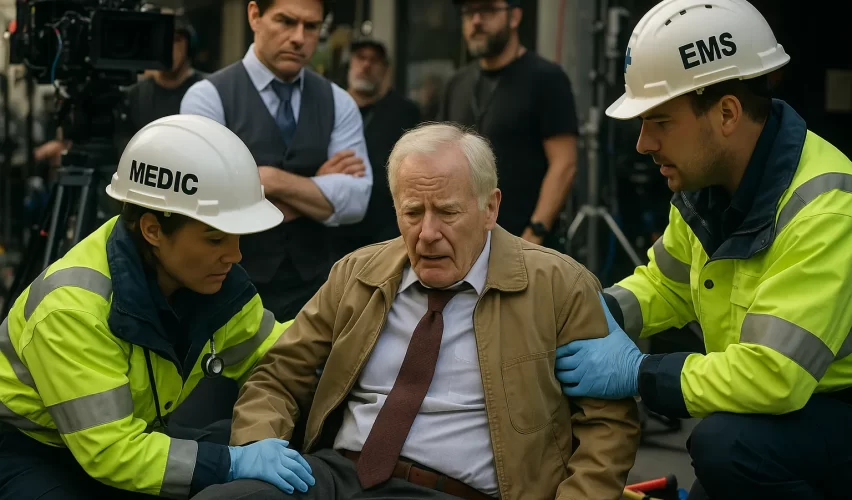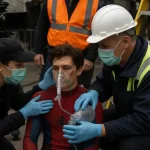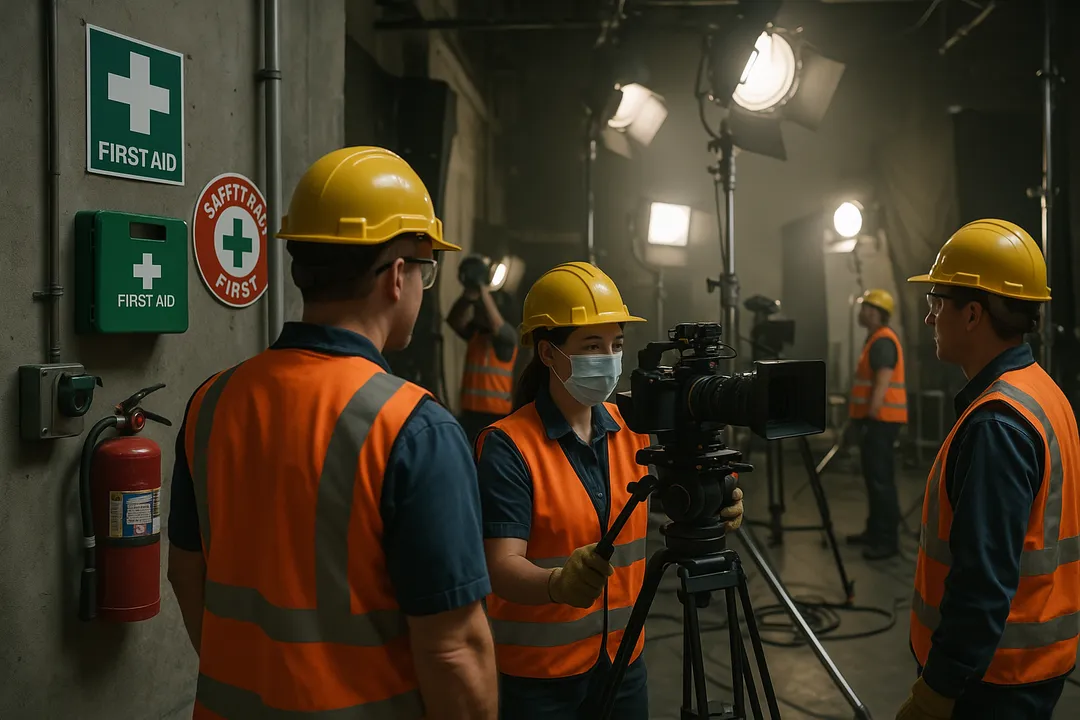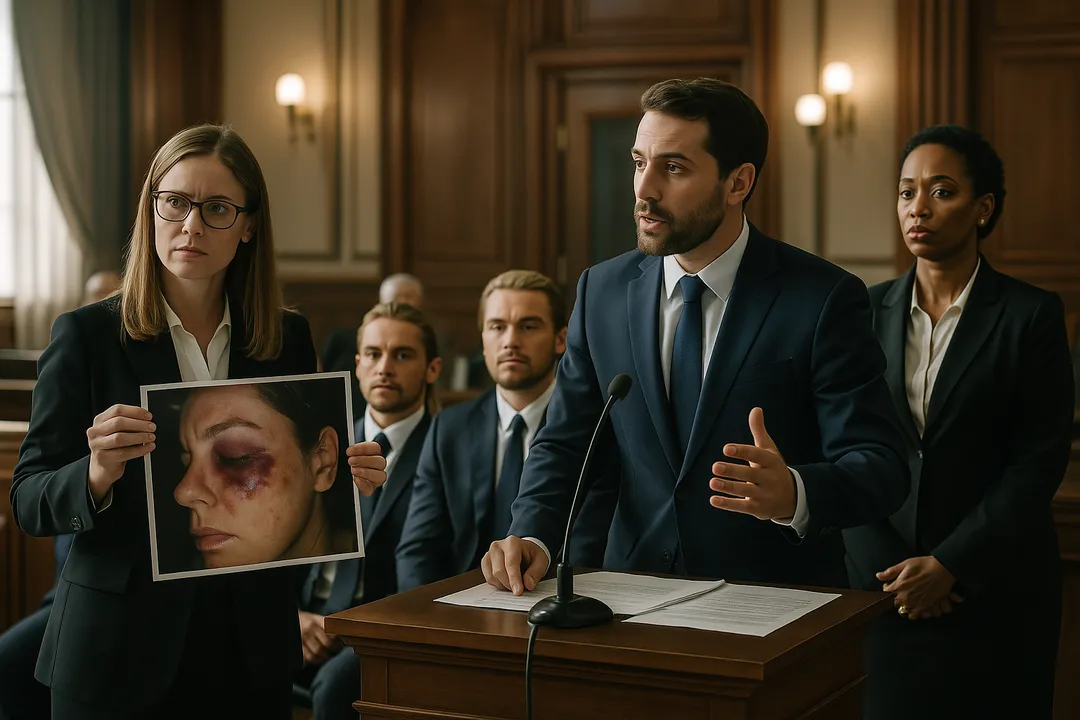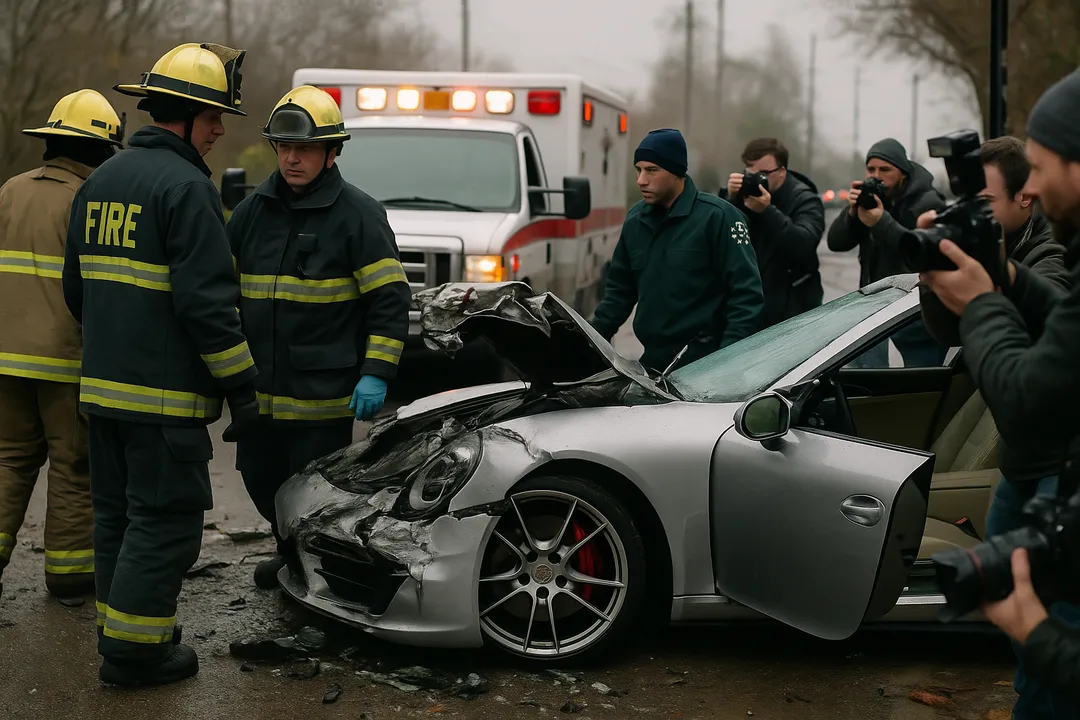Veteran actor John Goodman, 72, suffered a significant hip injury after falling on the set of an upcoming Tom Cruise film directed by Alejandro González Iñárritu, forcing production delays and raising important questions about the safety of older actors in physically demanding film environments. The incident, which occurred in October 2024 during filming in the United Kingdom, highlights the unique challenges and risks faced by aging performers in an industry that increasingly demands physical versatility from actors of all ages [1].
Goodman’s fall and subsequent hip injury represent more than just another celebrity accident; they underscore the complex intersection of age-related health considerations, film production pressures, and the entertainment industry’s evolving approach to accommodating performers across different life stages. The incident has prompted discussions about safety protocols for older actors, the physical demands of modern film production, and the legal and financial implications when veteran performers are injured on set.
The timing of Goodman’s injury is particularly significant given his status as one of Hollywood’s most respected character actors and his involvement in what is expected to be a major studio release featuring Tom Cruise. The production, helmed by acclaimed director Alejandro González Iñárritu, represents a high-profile collaboration that has attracted significant industry attention and investment, making any disruption particularly costly and complex to manage.
This incident also brings renewed focus to the broader issue of age discrimination and accommodation in Hollywood, a topic we’ve explored in our coverage of Celebrity Health Scares That Shook the World in 2025. As the entertainment industry grapples with an aging workforce and changing demographics, the need for appropriate safety measures and health considerations for older performers has become increasingly important.
The financial implications of Goodman’s injury extend beyond immediate medical costs to encompass production delays, schedule adjustments, and potential insurance claims. Major film productions operate on tight schedules with substantial daily costs, and injuries to key cast members can create cascading effects that impact not only the immediate production but also post-production timelines, marketing campaigns, and release schedules.
The Incident: Details of Goodman’s Fall
According to sources close to the production, John Goodman’s hip injury occurred during what was described as a routine scene that did not involve any particularly demanding physical activity or stunt work. The veteran actor was reportedly walking past Tom Cruise between takes when he suddenly lost his footing and fell to the ground, landing heavily on his hip in what witnesses described as an unexpected and alarming incident [2].
Goodman himself later described the fall in characteristically self-deprecating terms, explaining that “my legs just went on the floor, and I came up parallel to the ground and landed on my hip.” This description suggests that the fall may have been related to age-related balance issues, muscle weakness, or other factors that can affect mobility in older adults, rather than any external hazards or unsafe conditions on the set.
The immediate response to Goodman’s fall followed established emergency protocols for on-set injuries. Production was immediately halted, and the set’s medical personnel responded quickly to assess the severity of the injury and provide initial care. The decision to transport Goodman to a nearby hospital was made as a precautionary measure, given his age and the potential seriousness of hip injuries in elderly individuals.
Hip injuries are among the most serious and potentially life-threatening injuries that can occur in older adults. The risk of complications from hip fractures increases significantly with age, and the recovery process can be lengthy and challenging even with optimal medical care. The production team’s decision to seek immediate medical attention for Goodman reflects an understanding of these risks and the importance of prompt professional evaluation.
The circumstances surrounding Goodman’s fall have raised questions about whether additional safety measures should be implemented for older actors on film sets. While the incident did not involve any obviously dangerous activities, the reality is that routine movements and activities can pose greater risks for older individuals due to factors such as decreased bone density, reduced muscle strength, and changes in balance and coordination that naturally occur with aging.
The investigation into the cause of Goodman’s fall will likely examine various factors including the condition of the set flooring, lighting conditions, the presence of any obstacles or hazards, and whether appropriate safety measures were in place to assist older cast members in navigating the production environment. This analysis is important not only for determining liability and insurance coverage but also for identifying potential improvements that could prevent similar incidents in the future.
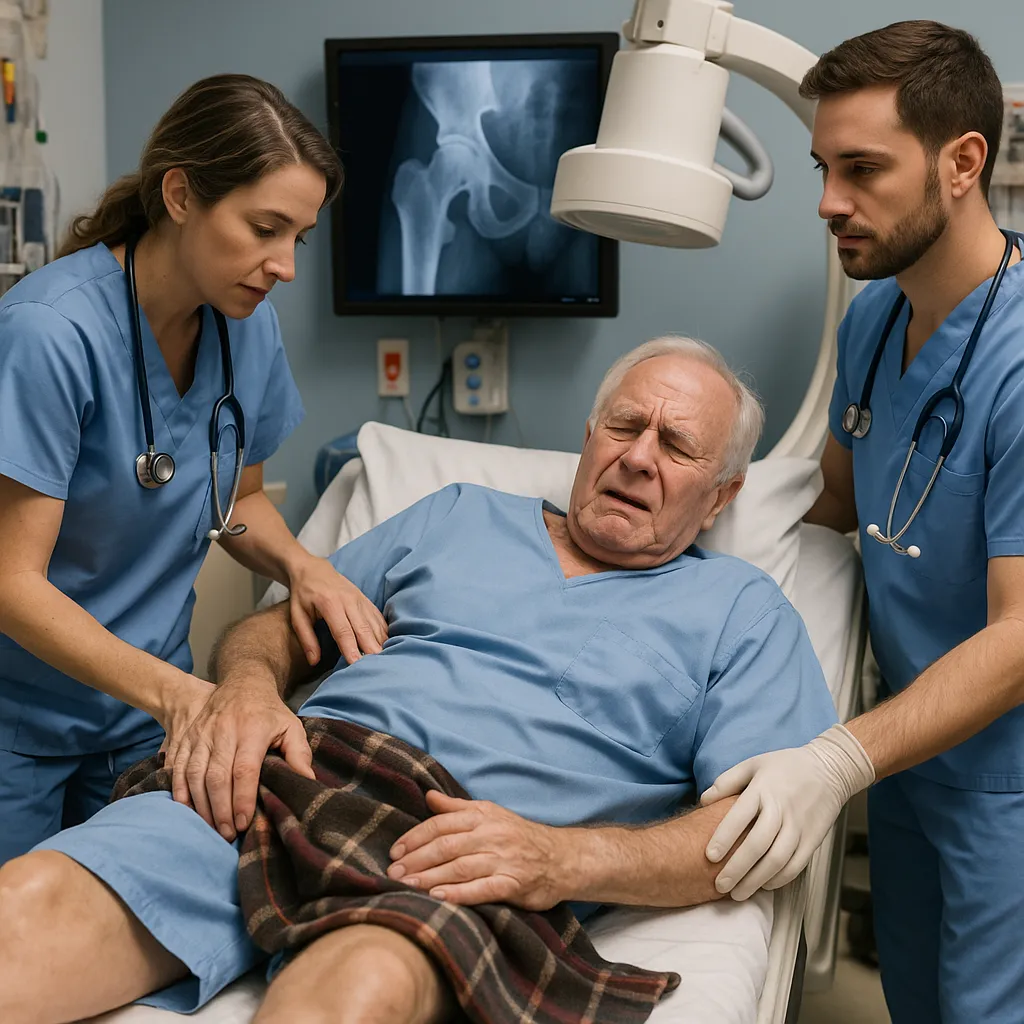
Medical Assessment and Treatment
Following his transport to the hospital, John Goodman underwent comprehensive medical evaluation to assess the extent of his hip injury and determine the appropriate course of treatment. Hip injuries in individuals over 70 years of age require particularly careful evaluation due to the increased risk of fractures, complications, and prolonged recovery periods that can significantly impact both health outcomes and professional obligations [3].
The medical team’s initial assessment would have included physical examination, imaging studies such as X-rays or CT scans, and evaluation of Goodman’s overall health status to determine his fitness for surgery if required. Hip injuries can range from minor bruising and soft tissue damage to serious fractures that require surgical intervention, and the specific nature of Goodman’s injury would determine both his treatment options and recovery timeline.
Age-related factors significantly complicate the treatment of hip injuries in older adults. Decreased bone density, common in individuals over 70, can make fractures more likely and more difficult to heal. Additionally, older patients may have underlying health conditions such as cardiovascular disease, diabetes, or other medical issues that can affect their ability to tolerate surgery and recover from injuries.
The decision-making process for treating Goodman’s injury would have involved balancing multiple factors including the severity of the injury, his overall health status, the potential benefits and risks of various treatment options, and the practical considerations related to his professional commitments. For a working actor, the timeline for recovery and return to full activity is particularly important given the financial and contractual implications of extended absence from work.
Pain management represents another crucial aspect of treating hip injuries in older adults. Effective pain control is essential not only for patient comfort but also for enabling the mobility and physical therapy that are crucial for optimal recovery. However, pain medications can pose particular risks for older patients, including increased risk of falls, cognitive impairment, and interactions with other medications.
The rehabilitation process for hip injuries in older adults typically involves physical therapy, occupational therapy, and gradual return to normal activities. For Goodman, this process would need to be tailored to address not only his general mobility needs but also the specific physical demands of his acting career, including the ability to stand for long periods, move around sets safely, and perform the physical actions required for his roles.
Production Impact and Industry Response
John Goodman’s hip injury created immediate and significant disruptions to the Tom Cruise film production, forcing the creative team to make rapid adjustments to shooting schedules, scene planning, and resource allocation. The incident highlighted the complex logistical challenges that arise when key cast members are unexpectedly unavailable, particularly in high-budget productions with tight schedules and multiple stakeholder interests [4].
The immediate production response involved halting filming and assessing the extent to which Goodman’s scenes could be rescheduled, modified, or potentially rewritten to accommodate his injury and recovery needs. This process requires collaboration between directors, producers, writers, and other key creative personnel to determine the most effective way to maintain the artistic integrity of the film while managing the practical constraints created by the actor’s unavailability.
The financial implications of the production delay extend far beyond Goodman’s medical expenses to encompass the substantial daily costs of maintaining a major film production. These costs include salaries for cast and crew members who remain on standby, continued rental fees for equipment and locations, and the complex expenses associated with rescheduling scenes that involve multiple actors with competing availability.
Insurance considerations play a crucial role in managing the financial impact of celebrity injuries on film productions. Major studio films typically carry comprehensive insurance policies that cover various scenarios including cast illness or injury, but the specific terms and coverage limits can significantly affect the production’s financial exposure. The age of the injured actor can be a particular factor in insurance coverage, as older performers may be considered higher risk for certain types of coverage.
The incident has also prompted broader discussions within the entertainment industry about the accommodation of older actors and the implementation of appropriate safety measures for performers across different age groups. As the industry workforce ages and life expectancy increases, production companies are increasingly recognizing the need for age-appropriate safety protocols and support systems.
Industry organizations including the Screen Actors Guild have used Goodman’s injury as an opportunity to emphasize the importance of existing safety protocols and to discuss potential enhancements that could better protect older performers. These discussions often focus on practical measures such as improved lighting, safer flooring materials, the availability of mobility assistance, and enhanced medical support on sets.
The response from fellow actors and industry professionals has been overwhelmingly supportive, with many expressing concern for Goodman’s well-being and emphasizing his professionalism and dedication throughout his long career. This support reflects both the personal respect that Goodman has earned within the industry and the broader recognition of the challenges faced by older performers in maintaining their careers.
Legal and Insurance Considerations
The legal and insurance implications of John Goodman’s hip injury are particularly complex due to his age, the circumstances of the accident, and the high-profile nature of the production. These factors create a multifaceted legal landscape that encompasses questions of liability, insurance coverage, contractual obligations, and potential accommodation requirements under disability and age discrimination laws [5].
Determining liability for Goodman’s injury requires careful analysis of the circumstances surrounding his fall and the safety measures that were in place at the time of the accident. While the incident appears to have been caused by Goodman’s own loss of balance rather than any obvious hazard or negligence, production companies still have legal obligations to provide safe working environments for all cast and crew members, regardless of age.
The investigation into the accident will examine various factors including the condition of the set, the adequacy of safety protocols, the availability of assistance for older cast members, and whether any reasonable accommodations should have been provided to reduce the risk of falls or other age-related injuries. This analysis is crucial for determining both legal liability and insurance coverage obligations.
Insurance coverage for celebrity injuries involves complex policies that address various scenarios including medical expenses, production delays, and potential replacement costs. The specific terms of coverage for older actors may include additional considerations related to age-related health risks, pre-existing conditions, and the increased likelihood of complications or extended recovery periods.
Workers’ compensation considerations may also apply, depending on the specific employment relationship between Goodman and the production company and the jurisdiction in which the filming occurred. While major stars often work as independent contractors, the specific terms of their engagement and the applicable laws can affect their rights to workers’ compensation benefits and the production company’s liability for workplace injuries.
The Americans with Disabilities Act (ADA) and similar legislation in other jurisdictions may also be relevant to Goodman’s situation, particularly if his injury results in temporary or permanent limitations that require accommodation. Production companies have legal obligations to provide reasonable accommodations for performers with disabilities, and these requirements may extend to age-related limitations or injuries sustained during production.
Contractual considerations add another layer of complexity to the legal implications of Goodman’s injury. His contract with the production company likely includes provisions addressing his obligations to perform, the production company’s responsibility to provide a safe working environment, and the procedures to be followed in the event of injury or illness. The specific terms of these provisions can significantly affect the rights and obligations of all parties involved.
The potential for third-party liability claims also exists if Goodman’s injury was caused or contributed to by defective equipment, unsafe conditions created by contractors or vendors, or other factors beyond the direct control of the production company. These claims could provide additional sources of recovery for damages but also create additional legal proceedings and potential complications.

Age-Related Challenges in Film Production
John Goodman’s hip injury highlights the unique challenges and considerations that arise when older actors participate in modern film productions. As the entertainment industry workforce ages and life expectancy increases, production companies are increasingly recognizing the need to address age-related safety concerns, health considerations, and accommodation requirements that were less prominent in earlier decades of filmmaking.
The physical demands of film production, while not always obvious to audiences, can be substantial even for roles that do not involve action sequences or stunt work. Long days on set, extended periods of standing or sitting, navigation of complex set environments, and exposure to various environmental conditions can all pose greater challenges for older performers than for their younger counterparts.
Age-related changes in vision, hearing, balance, and mobility can increase the risk of accidents and injuries on film sets, even during routine activities. These changes are a normal part of aging but require recognition and accommodation to ensure the safety and effectiveness of older performers. Production companies that fail to address these considerations may face increased liability risks and potential discrimination claims.
The entertainment industry has begun to develop specialized protocols and accommodations for older performers, including enhanced lighting to address vision changes, improved flooring and walkway safety, the availability of mobility assistance, and modified scheduling to account for different energy levels and recovery needs. These accommodations not only improve safety but can also enhance performance quality and job satisfaction for older actors.
Medical support and monitoring may also need to be enhanced for productions involving older performers. This can include more frequent health assessments, specialized medical personnel with expertise in geriatric care, and enhanced emergency response capabilities to address age-related health emergencies that may arise during production.
The legal framework surrounding age discrimination in employment provides additional protections for older performers and requirements for production companies. The Age Discrimination in Employment Act (ADEA) and similar legislation in other jurisdictions prohibit discrimination based on age and require employers to provide reasonable accommodations for age-related limitations, subject to certain exceptions and limitations.
Career longevity considerations also play an important role in addressing age-related challenges in film production. Many older actors have decades of experience and institutional knowledge that provide significant value to productions, making it worthwhile for the industry to invest in appropriate accommodations and support systems that enable continued participation by experienced performers.
The economic implications of age-related accommodations in film production are generally modest compared to the overall production budgets of major films, and the benefits of retaining experienced performers often outweigh the costs of providing appropriate support and safety measures. This economic reality, combined with legal requirements and ethical considerations, supports the continued evolution of industry practices to better accommodate older performers.
Recovery Process and Career Impact
John Goodman’s recovery from his hip injury involves not only the medical aspects of healing from the physical trauma but also the complex process of returning to full professional activity in an industry that demands both physical and emotional resilience. The recovery timeline for hip injuries in individuals over 70 can vary significantly depending on the severity of the injury, the individual’s overall health status, and their adherence to medical recommendations [6].
The initial phase of recovery typically involves pain management, mobility preservation or restoration, and prevention of complications that can arise from prolonged immobility. For older adults, the risk of complications such as blood clots, pneumonia, and muscle weakness increases significantly with extended bed rest or reduced activity, making early mobilization and appropriate physical therapy crucial components of the recovery process.
Physical therapy plays a central role in hip injury recovery, focusing on restoring strength, flexibility, and balance while gradually increasing activity levels to match the individual’s functional needs and goals. For an actor like Goodman, the physical therapy program would need to address not only basic mobility requirements but also the specific physical demands of his profession, including the ability to stand for extended periods, navigate set environments safely, and perform the movements required for his roles.
The psychological aspects of recovery from a significant injury can be particularly challenging for older adults, who may experience anxiety about future falls, concerns about their continued ability to work, and frustration with limitations on their independence and activity levels. These psychological factors can significantly impact both the recovery process and the individual’s overall quality of life and professional satisfaction.
Career implications of Goodman’s injury may include both immediate effects on current projects and longer-term considerations about future role selection and career planning. The immediate impact involves the current Tom Cruise production and any other projects that may be affected by his recovery timeline, while longer-term implications may include changes in the types of roles he pursues and the accommodations he may require for future work.
The entertainment industry’s response to Goodman’s injury and recovery will likely influence how similar situations are handled in the future. His experience may contribute to the development of enhanced safety protocols, improved accommodation procedures, and better support systems for older performers who experience injuries or health challenges during production.
Insurance considerations related to Goodman’s future work may also be affected by his injury history. Insurance companies that provide coverage for celebrity injuries often adjust their rates and requirements based on an actor’s medical history, and production companies may require additional safety measures or medical clearances for actors who have previously sustained serious injuries.
The support system available to Goodman during his recovery, including family, friends, medical professionals, and industry colleagues, will play a crucial role in both his physical healing and his emotional well-being during this challenging period. The entertainment industry has developed increasingly sophisticated support networks for performers facing health challenges, recognizing that these resources benefit not only individual actors but also the industry as a whole.
Industry Safety Evolution and Future Considerations
John Goodman’s hip injury serves as a catalyst for examining the evolution of safety practices in the entertainment industry and the ongoing need for improvements that address the unique risks faced by performers of all ages. The incident highlights both the progress that has been made in recent decades and the areas where continued development is needed to protect the health and safety of entertainment industry workers.
The entertainment industry has undergone significant transformation in its approach to safety over the past several decades, driven by a combination of regulatory requirements, insurance considerations, legal liability concerns, and ethical recognition of the importance of protecting worker health and safety. These changes have resulted in comprehensive safety protocols, specialized training programs, and sophisticated risk management systems that have substantially reduced the incidence and severity of workplace injuries.
However, the unique challenges posed by an aging workforce and the increasing physical demands of modern film production continue to create new safety considerations that require ongoing attention and innovation. The industry must balance the creative and commercial imperatives of filmmaking with the fundamental obligation to provide safe working environments for all participants, regardless of age or physical capabilities.
Technology has played an increasingly important role in improving film production safety, with innovations in equipment design, monitoring systems, and protective gear helping to reduce various types of risks. For older performers specifically, technological solutions may include improved lighting systems, safer flooring materials, mobility assistance devices, and enhanced communication systems that can help prevent accidents and facilitate rapid response when incidents occur.
Training and education programs for production personnel have also evolved to address age-related safety considerations, with specialized curricula that focus on recognizing and accommodating the needs of older performers. These programs emphasize not only technical safety measures but also the importance of respectful communication, appropriate accommodation, and the recognition that age-related changes are a normal part of the human experience rather than limitations to be overcome.
The regulatory environment surrounding entertainment industry safety continues to evolve, with government agencies, industry organizations, and advocacy groups working together to develop and implement standards that address emerging risks and changing workforce demographics. This collaborative approach helps ensure that safety requirements are both effective and practical for the unique demands of entertainment production.
International considerations also play an important role in entertainment industry safety, as major productions increasingly involve filming in multiple jurisdictions with different regulatory requirements, cultural norms, and available resources. The development of consistent international standards and best practices helps ensure that safety protections are maintained regardless of filming location.
The economic benefits of enhanced safety measures extend beyond the obvious advantages of preventing injuries and their associated costs. Safe working environments contribute to improved morale, increased productivity, enhanced reputation, and reduced legal and insurance expenses, making safety investments beneficial from both ethical and business perspectives.
Conclusion
John Goodman’s hip injury on the set of the Tom Cruise film represents a significant moment in the ongoing evolution of entertainment industry safety practices and the accommodation of older performers in modern film production. The incident highlights the complex intersection of age-related health considerations, production pressures, safety protocols, and the legal and financial frameworks that govern celebrity injuries in high-profile productions.
The comprehensive response to Goodman’s injury, from immediate medical care through production adjustments and industry-wide safety discussions, demonstrates the entertainment industry’s growing sophistication in managing the risks associated with an aging workforce. The incident has prompted valuable discussions about appropriate safety measures, reasonable accommodations, and the balance between creative vision and performer protection.
The legal and insurance implications of Goodman’s injury illustrate the complex risk management systems that have evolved to address the unique challenges of celebrity-driven film production. These systems provide essential protections for all parties involved while highlighting the ongoing need for adaptation and improvement as the industry workforce and production demands continue to evolve.
Perhaps most importantly, Goodman’s injury and the industry’s response to it contribute to ongoing efforts to create more inclusive and supportive working environments for performers of all ages. The recognition that older actors bring valuable experience, skill, and perspective to film productions, combined with the understanding that appropriate accommodations can enable continued participation, represents an important evolution in industry attitudes and practices.
The incident also underscores the importance of comprehensive medical care and support systems for entertainment industry workers who experience injuries or health challenges. The availability of appropriate medical resources, rehabilitation services, and professional support can significantly impact both recovery outcomes and career continuity for affected performers.
As Goodman continues his recovery and works toward returning to full professional activity, his experience will likely influence industry practices and policies regarding the safety and accommodation of older performers. The lessons learned from this incident will contribute to ongoing efforts to make film production safer and more inclusive for participants across all age groups and physical capabilities.
The entertainment industry’s commitment to learning from incidents like Goodman’s injury and continuously improving its safety practices is essential to protecting the health and careers of the talented individuals who create the entertainment that audiences enjoy. Through continued innovation in safety technology, enhanced training programs, improved accommodation procedures, and a culture that prioritizes the well-being of all production personnel, the industry can continue to evolve in ways that benefit both individual performers and the creative process as a whole.
The broader implications of Goodman’s injury extend beyond the entertainment industry to other sectors that employ older workers and face similar challenges in balancing productivity demands with age-related accommodation needs. The solutions and approaches developed in response to this incident may provide valuable insights and models for other industries grappling with similar issues in an aging workforce.
For more insights, explore our comprehensive articles on On-Set Accidents and Film Safety Protocols, Celebrity Lawsuit Trends in Injury Cases, Mental Health Injuries and Celebrity Recovery, and The Impact of Social Media on Celebrity Injury News Coverage.
Explore additional resources on John Goodman, 72, Gets ‘Immediate Medical Attention’ After Hip Injury – AOL, John Goodman ‘Experienced a Hip Injury’ During Tom Cruise Film Production – MSN, John Goodman Hip Injury Forces Production Delays on Major Film – Entertainment Weekly, Celebrity On-Set Injuries: Legal and Insurance Implications – Variety, and Hip Injury Recovery in Elderly Actors: Medical Considerations – The Hollywood Reporter.


